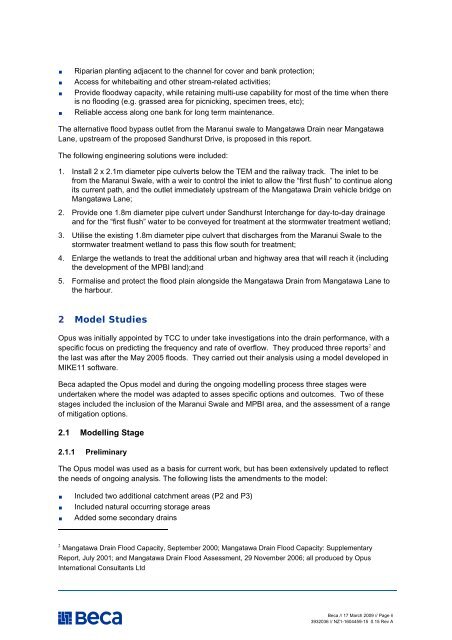2. Mangatawa catchment consents for earthworks, storm water ...
2. Mangatawa catchment consents for earthworks, storm water ...
2. Mangatawa catchment consents for earthworks, storm water ...
- No tags were found...
Create successful ePaper yourself
Turn your PDF publications into a flip-book with our unique Google optimized e-Paper software.
• Riparian planting adjacent to the channel <strong>for</strong> cover and bank protection;<br />
• Access <strong>for</strong> whitebaiting and other stream-related activities;<br />
• Provide floodway capacity, while retaining multi-use capability <strong>for</strong> most of the time when there<br />
is no flooding (e.g. grassed area <strong>for</strong> picnicking, specimen trees, etc);<br />
• Reliable access along one bank <strong>for</strong> long term maintenance.<br />
The alternative flood bypass outlet from the Maranui swale to <strong>Mangatawa</strong> Drain near <strong>Mangatawa</strong><br />
Lane, upstream of the proposed Sandhurst Drive, is proposed in this report.<br />
The following engineering solutions were included:<br />
1. Install 2 x <strong>2.</strong>1m diameter pipe culverts below the TEM and the railway track. The inlet to be<br />
from the Maranui Swale, with a weir to control the inlet to allow the “first flush” to continue along<br />
its current path, and the outlet immediately upstream of the <strong>Mangatawa</strong> Drain vehicle bridge on<br />
<strong>Mangatawa</strong> Lane;<br />
<strong>2.</strong> Provide one 1.8m diameter pipe culvert under Sandhurst Interchange <strong>for</strong> day-to-day drainage<br />
and <strong>for</strong> the “first flush” <strong>water</strong> to be conveyed <strong>for</strong> treatment at the <strong>storm</strong><strong>water</strong> treatment wetland;<br />
3. Utilise the existing 1.8m diameter pipe culvert that discharges from the Maranui Swale to the<br />
<strong>storm</strong><strong>water</strong> treatment wetland to pass this flow south <strong>for</strong> treatment;<br />
4. Enlarge the wetlands to treat the additional urban and highway area that will reach it (including<br />
the development of the MPBI land);and<br />
5. Formalise and protect the flood plain alongside the <strong>Mangatawa</strong> Drain from <strong>Mangatawa</strong> Lane to<br />
the harbour.<br />
2 Model Studies<br />
Opus was initially appointed by TCC to under take investigations into the drain per<strong>for</strong>mance, with a<br />
specific focus on predicting the frequency and rate of overflow. They produced three reports 2 and<br />
the last was after the May 2005 floods. They carried out their analysis using a model developed in<br />
MIKE11 software.<br />
Beca adapted the Opus model and during the ongoing modelling process three stages were<br />
undertaken where the model was adapted to asses specific options and outcomes. Two of these<br />
stages included the inclusion of the Maranui Swale and MPBI area, and the assessment of a range<br />
of mitigation options.<br />
<strong>2.</strong>1 Modelling Stage<br />
<strong>2.</strong>1.1 Preliminary<br />
The Opus model was used as a basis <strong>for</strong> current work, but has been extensively updated to reflect<br />
the needs of ongoing analysis. The following lists the amendments to the model:<br />
• Included two additional <strong>catchment</strong> areas (P2 and P3)<br />
• Included natural occurring storage areas<br />
• Added some secondary drains<br />
2 <strong>Mangatawa</strong> Drain Flood Capacity, September 2000; <strong>Mangatawa</strong> Drain Flood Capacity: Supplementary<br />
Report, July 2001; and <strong>Mangatawa</strong> Drain Flood Assessment, 29 November 2006; all produced by Opus<br />
International Consultants Ltd<br />
Beca // 17 March 2009 // Page 6<br />
3932036 // NZ1-1604459-15 0.15 Rev A
















